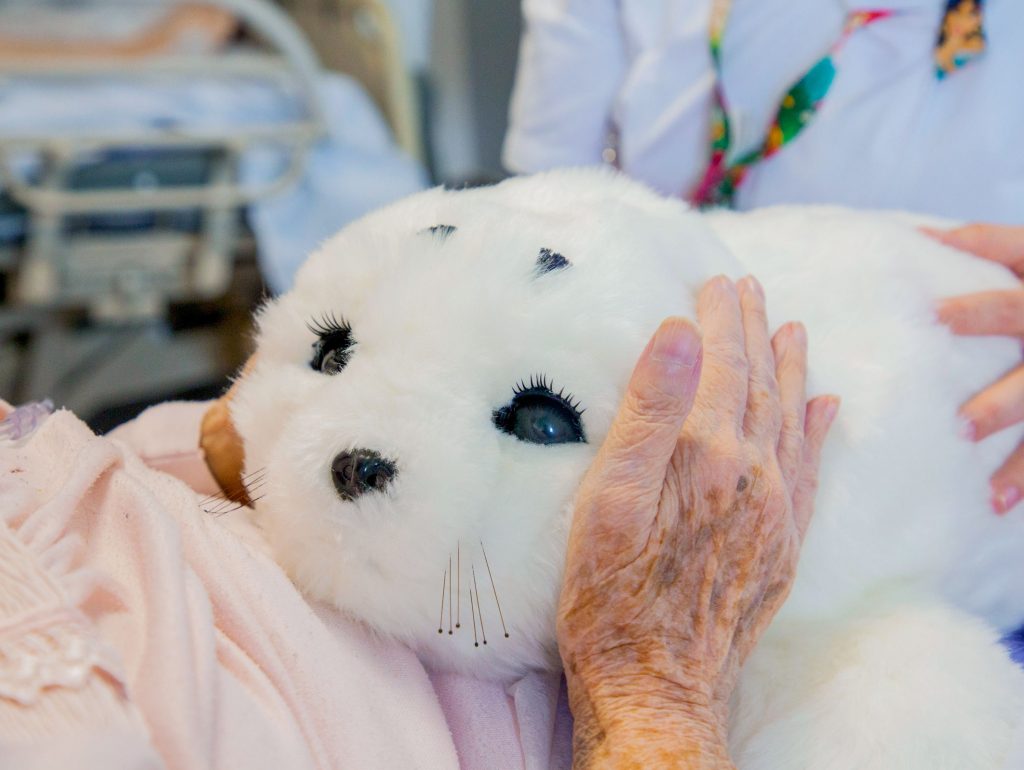Robotic Therapy Pets are helping to fill a gap in the societal need for companionship and care of the elderly. These robotic pets can provide more personalized, interactive, and tailored therapy to individual needs than other forms of therapy.
They offer various benefits, including alleviating loneliness or boredom; providing unconditional love and affection; being non-judgmental listeners who do not discriminate against topics discussed; creating bonds with family members by sharing a common interest in their new pet robot; or offering an opportunity for exercise through playtime activities like chasing games.
Depression, Dementia, and Social Isolation in Seniors
Seniors are constantly fighting problems with depression, dementia, and social isolation. Loneliness and social isolation have now been acknowledged as a public health concern for older people and are linked to measurably poorer mental and physical health.
In 2018, a survey found that about 1/3 of adults older than 45 felt lonely. Research has also shown that 20% of people 60 and older are affected by mental disorders, including dementia, which can trigger depression.
These are all major problems in the aging population and as awareness of these problems arises, so too do possible solutions. One of the solutions may be robotic therapy pets.
What are therapy robot pets?
Therapy robots are designed to provide companionship and therapeutic value for elderly people. Robot pets are just a type of therapy robot that comes in the form of an animal.
Therapy robot pets on the market currently include dogs, cats, and even baby seals.
They can be programmed with a variety of activities and offer advanced sensors that respond to touch and voice.
Robotic pet companions were originally used to comfort adults with dementia. The idea was that those with reduced cognitive capacity would accept the robots as real animals and, thus, would be able to have a companion.
A 2017 study assessed the effectiveness of PARO the robotic seal and found that the therapy robot was helpful in treating the symptoms of dementia. Another study found that robotic pets reduce loneliness and depression in the elderly.
But will they actually become a part of caregiving?
Will robot pets be part of our elder care future?
Research has found that real animal-assisted therapy improves mood and quality of life for seniors. According to a 2012 study, dogs help reduce stress, anxiety, loneliness, and depression and lead to lower blood pressure and decreased chances of developing heart disease.
Therapy robot pets offer similar benefits as a low-maintenance option. This is the perfect solution for seniors who are no longer able to care for a pet due to mobility limitations and cognitive impairments.
The possibility of robotic pets being implemented into an assisted living community near you is pretty high. In fact, there have already been some communities that have bought robotic companions for their patients, and they have seen major positive feedback.
Companion robots, like PARO, have been used in nursing homes since the early 2000s.
In 2018, the Office for the Aging began a pilot program that gave robotic pets to isolated seniors. After just a year, 70% of the seniors saw a reduction in feeling isolated.
The Florida Department of Elder Affairs has continuously provided robot dogs to socially isolated seniors with Alzheimer’s disease and related dementia. Initially, the agency bought 375 robotic pets, but due to outstanding feedback and increased demand after COVID-19, they decided to order a total of 1,800.
Facilities in Texas and Kansas followed 61 residents with dementia who had 20-minute group sessions with the PARO robotic seal three days a week over the course of three months. The residents had decreased stress and anxiety, which allowed for decreased medication for pain and behavioral problems.
It’s safe to say that elder care communities are already implementing therapy robots into their facilities and are seeing outstanding feedback. This is still a new industry, so the demand is still relatively low, but over time, as technology advances, you can expect to see these battery-powered furry friends in a facility near you.
But what about seniors that are choosing to age in place?

Robotic Emotional Support Pets for Seniors Aging in Place
Community settings offer a way for seniors to socialize with other people their age. Most communities offer activities that focus on social interaction and cognitive engagement.
Seniors who are living in their homes often don’t get the same treatment. They have an increased risk of isolation and depression.
Currently, high-end price tags have put most robotic therapy pets out of reach for seniors in the U.S., where millions of elderly individuals are at or near the federal poverty line.
Fortunately, companies are beginning to provide robotic companions at affordable prices. Tombot’s robotic emotional support dog, Jennie, retails for just $500, and Ageless Innovation’s Joy for All cats and dogs cost only $100.
These more affordable options aren’t as advanced as some of their high-end counterparts but still offer a loveable friend for your loved one. They offer a realistic animatronic pet that uses advanced programming and sensors to return realistic, animal-like movements and sounds.
The Benefits of Therapeutic Robopets
Just like living therapy animals, robotic therapy pets have been found to offer similar health benefits to seniors without the responsibilities of caring for a living animal. And although robotic pets might have their flaws, a robotic companion is likely better than no companion at all.
Whether your loved one wants a pet but can’t care for a living animal or they are feeling lonely or have dementia, a robotic therapy pet could help them.
Benefits of owning a robot companion include:
- Reduce feelings of loneliness
- Prevent heart disease
- Decrease symptoms caused by dementia
- Encourage seniors to live independently
- Provide a friend that your loved one can talk to and laugh with
- Increase the quality of life of your loved one
- Lessen levels of anxiety
- Reduce depression
- Lower blood pressure
- Encourage exercise and an active lifestyle

Buying Your Loved One A Robot Companion
If you think your loved one can benefit from a robot pet, follow the tips and advice below. This will ensure you get the right companion for your loved one that fits your budget, their medical needs, and their preferences.
Your Budget
Before you look for a robotic therapy pet, you should know what your budget is. Costs of these companions range anywhere from $100 to $10,000, so understanding how much you are willing to spend will help in your search.
Remember that regardless of how much you spend, it will likely still be cheaper than if you were to buy a living pet. Between pet food, veterinary visits, and shots, keeping a living animal happy and healthy is expensive. Over time, you will likely spend way more than the one-time price of a robot pet.
If you need financial assistance, some government programs will cover certain therapy robots. For instance, the U.S. Food and Drug Administration classifies PARO as a biofeedback device, meaning Medicare will cover its purchase if used as a therapy device.
Medical Needs
Some robot companions offer more extensive care and options than others. If your loved one has an increased need of care, is diagnosed with dementia, or is feeling severe depression, a more advanced robot may help.
These more expensive options offer higher functionality, more realistic movements and sounds, advanced A.I. and machine learning, and more. Some of these robots are even able to set reminders, announce the weather and news, or tell engaging stories.
Assess your loved one’s needs and use this to filter your search.
Preferences
Talk to your loved one about what they are looking for in a companion. What is their ideal robotic friend like? Would they prefer a cat, a dog, or some other animal?
Do they just want someone to talk with, or are they wanting extended capabilities of dancing with their newly found friend?
It’s important to find a robot pet companion that they will actually want to use. If they don’t enjoy time with it, then it was a waste of money. Make sure you find a robot that they will love to spend time with.
This will ensure you get positive results that could increase their quality of life.
The Bottom Line
The benefits of robotic therapy pets in the elderly population are immeasurable. It’s clear from all angles that a need exists for more research to be done on this topic, as it has been shown to have such tremendous effects. The most obvious benefit is increased socialization and companionship, which can drastically improve an individual’s quality of life.
If you are looking to purchase a robotic companion for your loved one, read our article on The Top 9 Elder Care Robots Available Right Now for pricing and availability information.




